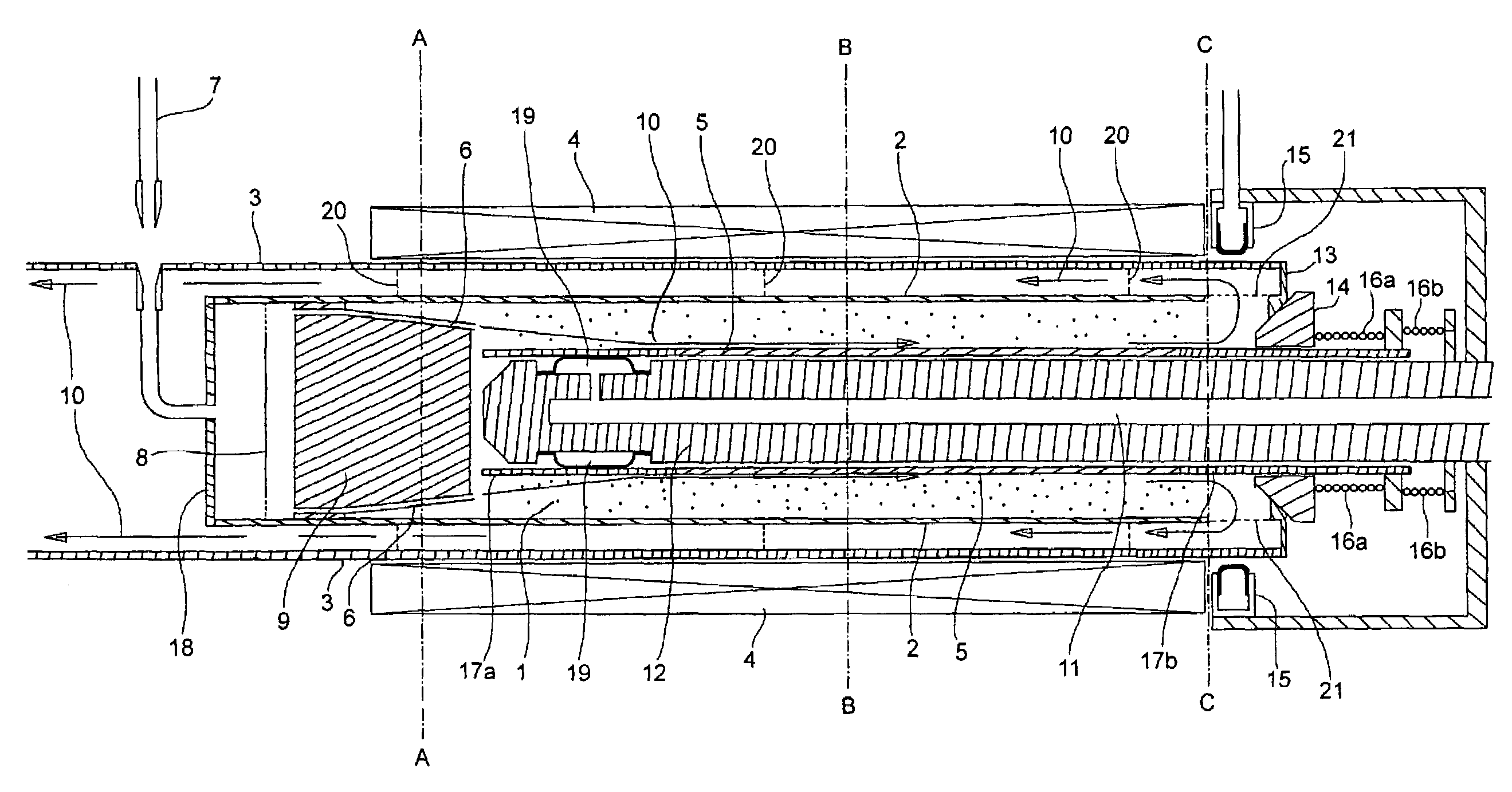Surface roughening treatment method of object being treated, and apparatus therefor
a surface roughening treatment and object technology, applied in the direction of lapping machines, instruments, manufacturing tools, etc., can solve the problems of large-scale equipment, derusting of such methods, and reducing efficiency in rotational utilization, so as to achieve high quality of goods
- Summary
- Abstract
- Description
- Claims
- Application Information
AI Technical Summary
Benefits of technology
Problems solved by technology
Method used
Image
Examples
example 1
[0018]An apparatus shown in FIG. 1, that is, an apparatus having the following constituent members, was used. In addition, FIGS. 2 to 4 are a cross sectional view taken along the line A—A in FIG. 1, a cross sectional view taken along the line B—B, and a cross sectional view taken along the line C—C (for the sake of avoiding complexity in the figures, a rotational magnetic field generating device 4 described later is indicated by lines. Also, abrasive grains as a surface roughening medium are symbolically shown in the figures as well as FIG. 1). Here, in descriptions regarding directions in the specification as well as in claims, “right” indicates a sense toward the line C—C from the line A—A in FIG. 1 while “left” indicates a sense toward the line A—A from the line C—C in FIG. 1.
(1) Rotational Magnetic Field Generating Device 4:
[0019]The device is composed of two-pole stator (inner diameter: 83 mmΦ, length of coil winding: 475 mm) (the stator is electrically connected to a three-pha...
example 2
[0039]Surface roughening treatment on objects 5 being treated (the number of objects being 20) was performed in the same apparatus and operating condition as those in the example 1 except that no introduction of compressed air into a surface roughening treatment vessel 2 was made and that “demagnetizing operation” and “abrasive grain uniformizing operation in an axial direction” were not performed. Like the example 1, a first object being treated involved less adherence of fine powder resulted from the object being treated, and had white surfaces. Also, no difference in dent density in a longitudinal direction was found on the object 5 being treated (a state shown in FIG. 6(d)). However, it was recognized that a second object being treated involved somewhat adherence of fine powder resulted from the object being treated, surfaces of a third object being treated began to become black, the more the number of objects being treated, the more adherence of fine powder resulted from an obj...
example 3
[0041]Surface roughening treatment on objects 5 being treated (the number of objects being 20) was performed in the same apparatus and operating condition as those in the example 2 except that after surface roughening treatment of one object 5 being treated was terminated, only a work and the iron core 12 were taken out from the rotational magnetic field generating device 4, and after a cover or the like (whatever will do provided that the central hole of the seal member 13 was plugged) plugged, introduction of compressed air and application of voltage were simultaneously performed for 30 seconds, introduction of compressed air was stopped and only application of voltage was performed for 5 seconds, and then a new work was charged. Like a first object being treated, second and succeeding objects being treated involved less adherence of fine powder resulted from the objects being treated, and the objects 5 being treated kept white surfaces. Of course, no difference in dent density in...
PUM
| Property | Measurement | Unit |
|---|---|---|
| length | aaaaa | aaaaa |
| inner diameter | aaaaa | aaaaa |
| length | aaaaa | aaaaa |
Abstract
Description
Claims
Application Information
 Login to View More
Login to View More - R&D
- Intellectual Property
- Life Sciences
- Materials
- Tech Scout
- Unparalleled Data Quality
- Higher Quality Content
- 60% Fewer Hallucinations
Browse by: Latest US Patents, China's latest patents, Technical Efficacy Thesaurus, Application Domain, Technology Topic, Popular Technical Reports.
© 2025 PatSnap. All rights reserved.Legal|Privacy policy|Modern Slavery Act Transparency Statement|Sitemap|About US| Contact US: help@patsnap.com



